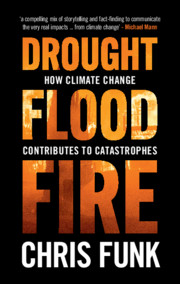Book contents
- Drought, Flood, Fire
- Drought, Flood, Fire
- Copyright page
- Contents
- Acknowledgments
- 1 Climate Extremes, Climate Attribution, Extreme Event Attribution
- 2 Welcome to an Awesome Planet
- 3 The Earth Is a Negentropic System, or “the Bright Side of Empty”
- 4 Do-It-Yourself Climate Change Science
- 5 Temperature Extremes – Impacts and Attribution
- 6 Precipitation Extremes
- 7 Hurricanes, Cyclones, and Typhoons
- 8 Conceptual Models of Climate Change and Prediction, and How They Relate to Floods and Fires
- 9 Climate Change Made the 2015–2016 El Niño More Extreme
- 10 Bigger La Niñas and the East African Climate Paradox
- 11 Fire and Drought in the Western United States
- 12 Fire and Australia’s Black Summer
- 13 Driving toward +4°C on a Dixie® Cup Planet
- 14 We Can Afford to Wear a White Hat
- Appendix A Few Resources for Further Reading and Research
- Index
10 - Bigger La Niñas and the East African Climate Paradox
Published online by Cambridge University Press: 01 June 2021
- Drought, Flood, Fire
- Drought, Flood, Fire
- Copyright page
- Contents
- Acknowledgments
- 1 Climate Extremes, Climate Attribution, Extreme Event Attribution
- 2 Welcome to an Awesome Planet
- 3 The Earth Is a Negentropic System, or “the Bright Side of Empty”
- 4 Do-It-Yourself Climate Change Science
- 5 Temperature Extremes – Impacts and Attribution
- 6 Precipitation Extremes
- 7 Hurricanes, Cyclones, and Typhoons
- 8 Conceptual Models of Climate Change and Prediction, and How They Relate to Floods and Fires
- 9 Climate Change Made the 2015–2016 El Niño More Extreme
- 10 Bigger La Niñas and the East African Climate Paradox
- 11 Fire and Drought in the Western United States
- 12 Fire and Australia’s Black Summer
- 13 Driving toward +4°C on a Dixie® Cup Planet
- 14 We Can Afford to Wear a White Hat
- Appendix A Few Resources for Further Reading and Research
- Index
Summary
In May 2016, the author traveled to Washington, DC to warn the food security community about a potential food crisis in East Africa if a 2016–2017 La Niña followed the 2015–2016 El Niño. This assertion, unfortunately, turned out true, and East Africa suffered a series of brutal back-to-back droughts in late 2016 and early 2017. Supporting this effective early warning was an understanding of how climate change is making La Niña events more extreme, and how climate change has contributed to a drying trend over eastern East Africa, placing millions of people in peril. This chapter uses personal accounts and research by the author to describe how climate change contributed to the March–May 2017 drought. La Niña events cool the equatorial East Pacific. Climate change has resulted in warm “Western V” ocean water that wraps around this cool region, amplifying its drought-inducing efficacy. This makes naturally occurring La Niñas more intense and hazardous. To explore the impact of human-induced warming, a formal attribution study is presented and described. In 2017, March–May Western V sea surface temperatures were the warmest on record, and climate change certainly contributed to the severely dry conditions over East Africa, helping place more than 13 million people in peril.
Keywords
- Type
- Chapter
- Information
- Drought, Flood, FireHow Climate Change Contributes to Catastrophes, pp. 212 - 233Publisher: Cambridge University PressPrint publication year: 2021

